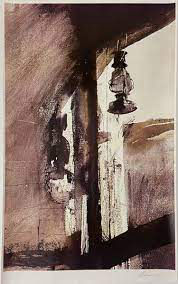
Shed Lantern
Caught in the Light of ‘Shed Lantern’
Andrew Wyeth hated it when people caught him at work, or spotted him with a watercolour block under his arm, so he found a way to minimize those dreaded encounters. Although famed for his tempera technique, which he was fond of, but which took up to six months to dry, Andrew discovered drybrush painting, a method that enabled him to work much faster. Not only did it take away the lengthy timeline associated with tempera, but it also offered Wyeth greater opportunity to elude any curious onlookers while he worked. ‘Shed Lantern’ was created during one of those ‘dodging’ adventures.
Not far from the Wyeth family home in Chadds Ford, Pennsylvania, stood a shed owned by Adam Johnson, described in Andrew Wyeth’s words as “a wonderful looking Negro whom I have never caught” (meaning, rightly caught on canvas). One day in 1954, he entered the shed, and upon noticing a hanging red lantern, decided to paint the object in drybrush watercolour on paper; hence, ‘Shed Lantern’ was born.